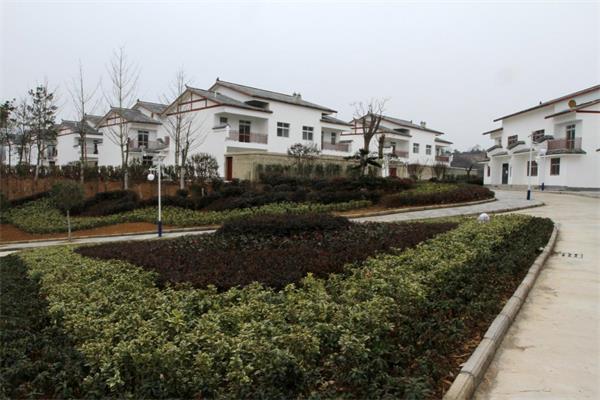


Pictured is a landscaping feature at aresettlement estate, which is part of the local government’s poverty reduction project, in Fangxian county, Central China’s Hubei Province on February 23. Altogether 7,528 people in 1,882 households moved into the newly-built ecological community. (People's Daily/Zhang Qilong and Liu Feng)
Thanks to the continuous efforts made by the Chinese government to improve people’s livelihood, the growth of average income has outpaced that of the GDP during the past two years.
Though China’s economic growth has slowed down in recent years, the government devoted more efforts to improving the lives of it’s people, including areas of education, employment, social security, income and medical treatment, since the 18th National Congress of the Communist Party of China (CPC).
"The people's longing for a good life is what we are fighting for," Chinese President Xi Jinping said in his first public speech as general secretary of the CPC Central Committee, reaffirming the determination of the CPC and the government to serve the people.
As a result, money cut down from government expenditures, such as public consumption and construction, has been utilized to help improve the lives of Chinese citizens.
From 2011 to 2014, social spending was increased by 40 percent. The growth rate was higher than that of the fiscal expenditure over the same period.
In 2015, though China’s GDP growth slowed to 6.9 percent,the national per capitadisposableincome grew by 7.4 percent from 2014 in real terms. Moreover, the income growth of rural residents in recent years was higher than that of urban dwellers.
For example, Luotuowan village in Fupingcounty, North China’s Hebei Province, used to be a village of exceptional poverty. Thanks to favorable policies, Tang Rongbin, a local resident, was able to renovate his brick house into a modern apartment before the traditional Chinese New Year.
China’s education reform has also entered new stages. Nine-year compulsory education was extended to 93 percent of school-age children in 2015, higher than the average level of countries with high income.
The gross entrance rate for tertiary education reached 40 percent, surpassing the average level of middle- and high- income countries .Both numbers have already reached the 2020 goals proposed in the national education plan.
Facing downward economic pressure, the Chinese government introduced a series of preferential policies to boost employment and encourage entrepreneurship in the last three years.
In 2015, China created 13.12 million new jobs in urban areas, and also held urban unemployment below 4.5 percent. In addition, over 1.3 billion people are registered for health insurance, coveringmore than 95 percent of the total population.
Li Chaoqun from Southwest China’s Chongqing Municipality is one of those benefiting from medical coverage. “I suffered from hepatopathy 10 years ago, and I had to borrow thousands of yuan to cover my medical bills,” he said, adding that he now can stay focused on his treatment.
Thanks to the above efforts, the average life expectancy for Chinese in 2015 was estimated to be one year longer than that in 2010.
 Engineer troop builds bridge in real combat conditions
Engineer troop builds bridge in real combat conditions You can urinate in public in Chongqing
You can urinate in public in Chongqing Rice terrace scenery in southwest China's Yunnan
Rice terrace scenery in southwest China's Yunnan 2016 Miss Chinatown USA pageant held in San Francisco
2016 Miss Chinatown USA pageant held in San Francisco Ancient pagodas across China
Ancient pagodas across China Wedding dress show up in the air
Wedding dress show up in the air Candidates perform in 2nd examination at Beijing Film Academy
Candidates perform in 2nd examination at Beijing Film Academy Russian photographer brings fairytales to life
Russian photographer brings fairytales to life Chinese beauties, foreign models meet in Chengdu
Chinese beauties, foreign models meet in Chengdu Top 20 hottest women in the world in 2014
Top 20 hottest women in the world in 2014 Top 10 hardest languages to learn
Top 10 hardest languages to learn 10 Chinese female stars with most beautiful faces
10 Chinese female stars with most beautiful faces China’s Top 10 Unique Bridges, Highways and Roads
China’s Top 10 Unique Bridges, Highways and Roads G20 pledges to avoid currency war
G20 pledges to avoid currency war Pro-independence forces rip Taiwan apart
Pro-independence forces rip Taiwan apart China’s ‘fakes fighters’ sue companies over knockoffs
China’s ‘fakes fighters’ sue companies over knockoffs Net watchdog closes tycoon’s social media accounts
Net watchdog closes tycoon’s social media accountsDay|Week